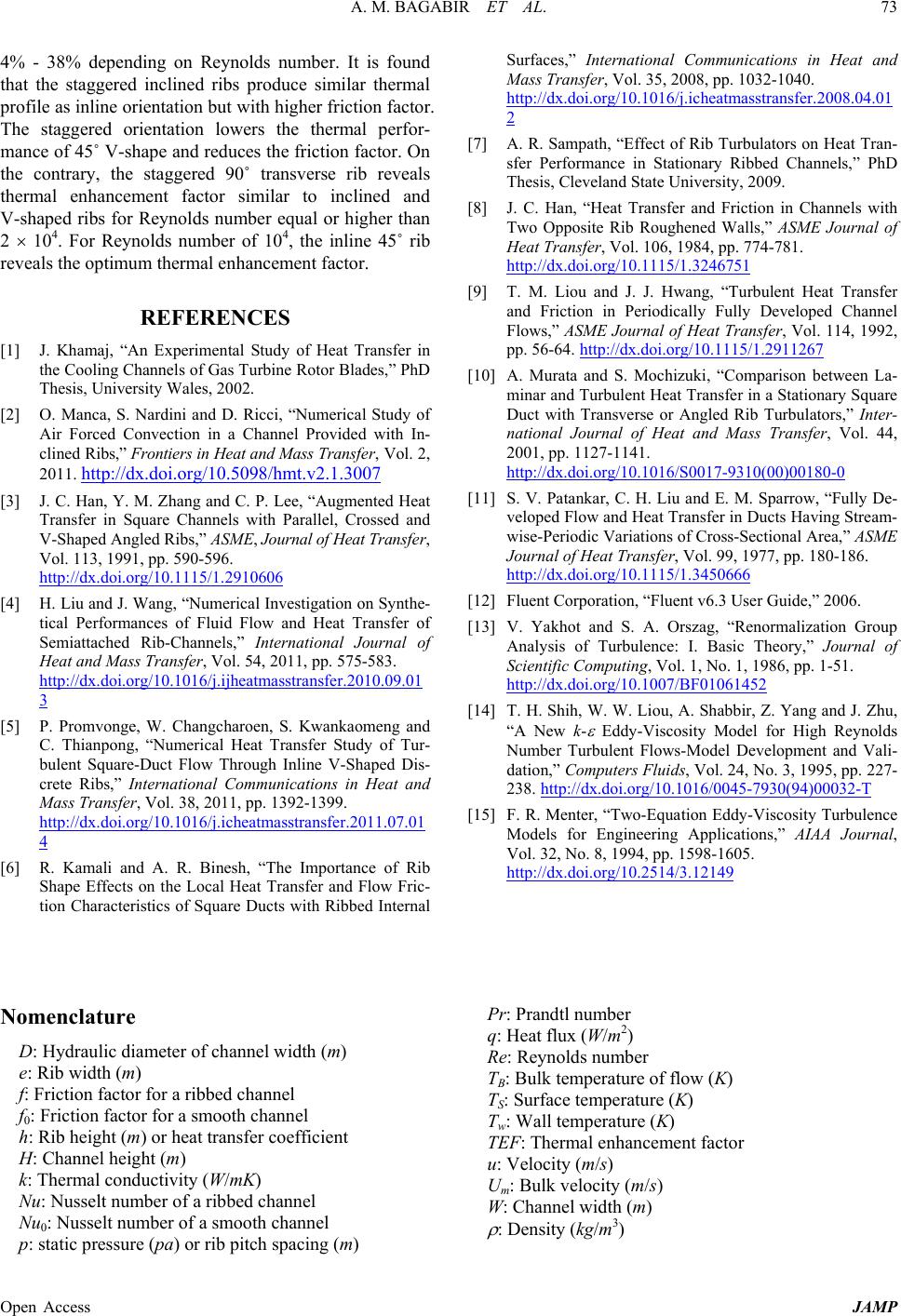
A. M. BAGABIR ET AL.
Open Access JAMP
4% - 38% depending on Reynolds number. It is found
that the staggered inclined ribs produce similar thermal
profile as inline orientation but with higher friction factor.
The staggered orientation lowers the thermal perfor-
mance of 45˚ V-shape and reduces the friction factor. On
the contrary, the staggered 90˚ transverse rib reveals
thermal enhancement factor similar to inclined and
V-shaped ribs for Reynolds number equal or higher than
2 × 104. For Reynolds number of 104, the inline 45˚ rib
reveals the optimum thermal enhancement factor.
REFERENCES
[1] J. Khamaj, “An Experimental Study of Heat Transfer in
the Cooling Channels of Gas Turbine Rotor Blades,” PhD
Thesis, University Wales, 2002.
[2] O. Manca, S. Nardini and D. Ricci, “Numerical Study of
Air Forced Convection in a Channel Provided with In-
clined Ribs,” Frontiers in Heat and Mass Transfer, V ol. 2,
2011. http://dx.doi.org/10.5098/hmt.v2.1.3007
[3] J. C. Han, Y. M. Zhang and C. P. Lee, “Augmented Heat
Transfer in Square Channels with Parallel, Crossed and
V-Shaped Angled Ribs,” ASME, Journal of Heat Transfer,
Vol. 113, 1991, pp. 590-596.
http://dx.doi.org/10.1115/1.2910606
[4] H. Liu and J. Wang, “Numerical Investigation on Synthe-
tical Performances of Fluid Flow and Heat Transfer of
Semiattached Rib-Channels,” International Journal of
Heat and Mass Transfer, Vol. 54, 2011, pp. 575-583.
http://dx.doi.org/10.1016/j.ijheatmasstransfer.2010.09.01
3
[5] P. Promvonge, W. Changcharoen, S. Kwankaomeng and
C. Thianpong, “Numerical Heat Transfer Study of Tur-
bulent Square-Duct Flow Through Inline V-Shaped Dis-
crete Ribs,” International Communications in Heat and
Mass Transfer, Vol. 38, 2011, pp. 1392-1399.
http://dx.doi.org/10.1016/j.icheatmasstransfer.2011.07.01
4
[6] R. Kamali and A. R. Binesh, “The Importance of Rib
Shape Effects on the Local Heat Transfer and Flow Fric-
tion Characteristics of Square Ducts with Ribbed Internal
Surfaces,” International Communications in Heat and
Mass Transfer, Vol. 35, 2008, pp. 1032-1040.
http://dx.doi.org/10.1016/j.icheatmasstransfer.2008.04.01
2
[7] A. R. Sampath, “Effect of Rib Turbulators on Heat Tran-
sfer Performance in Stationary Ribbed Channels,” PhD
Thesis, Cleveland State University, 2009.
[8] J. C. Han, “Heat Transfer and Friction in Channels with
Two Opposite Rib Roughened Walls,” ASME Journal of
Heat Transfer, Vol. 106, 1984, pp. 774-781.
http://dx.doi.org/10.1115/1.3246751
[9] T. M. Liou and J. J. Hwang, “Turbulent Heat Transfer
and Friction in Periodically Fully Developed Channel
Flows,” ASME Journal of Heat Transfer, Vol. 114, 1992,
pp. 56-64. http://dx.doi.org/10.1115/1.2911267
[10] A. Murata and S. Mochizuki, “Comparison between La-
minar and Turbulent Heat Transfer in a Stationary Square
Duct with Transverse or Angled Rib Turbulators,” Inter-
national Journal of Heat and Mass Transfer, Vol. 44,
2001, pp. 1127-1141.
http://dx.doi.org/10.1016/S0017-9310(00)00180-0
[11] S. V. Patankar, C. H. Liu and E. M. Sparrow, “Fully De-
veloped Flow and Heat Transfer in Ducts Having Stream-
wise-Periodic Variations of Cross-Sectional Area,” ASME
Journal of Heat Transfer, Vol. 99, 1977, pp. 180-186.
http://dx.doi.org/10.1115/1.3450666
[12] Fluent Corporation, “Fluent v6.3 User Guide,” 2006.
[13] V. Yakhot and S. A. Orszag, “Renormalization Group
Analysis of Turbulence: I. Basic Theory,” Journal of
Scientific Computing, Vol. 1, No. 1, 1986, pp. 1-51.
http://dx.doi.org/10.1007/BF01061452
[14] T. H. Shih, W. W. Liou, A. Shabbir, Z. Yang and J. Zhu,
“A New k-
ε
Eddy-Viscosity Model for High Reynolds
Number Turbulent Flows-Model Development and Vali-
dation,” Computers Fluids, Vol. 24, No. 3, 1995, pp. 227-
238. http://dx.doi.org/10.1016/0045-7930(94)00032-T
[15] F. R. Menter, “Two-Equat ion Eddy -Viscosity Turbulence
Models for Engineering Applications,” AIAA Journal,
Vol. 32, No. 8, 1994, pp. 1598-1605.
http://dx.doi.org/10.2514/3.12149
Nomenclature
D: Hydraulic diameter of channel width (m)
e: Rib width (m)
f: Friction factor for a ribbed channel
f0: Friction factor for a smooth channel
h: Rib height (m) or heat transfer coefficient
H: Channel height ( m)
k: Thermal conductivity (W/mK)
Nu: Nusselt nu mber of a ribbed channel
Nu0: Nusselt number of a smooth channel
p: static pressure (pa) or rib pitch spacing (m)
Pr: Prandtl number
q: Heat flux (W/m2)
Re: Reynol ds number
TB: Bulk tem pe rature of flow (K)
TS: Surface temperature (K)
Tw: Wall temperature (K)
TEF: Thermal enhancement factor
u: Velocity (m/s)
Um: Bulk velocity (m/s)
W: Channel wi dth (m)
ρ
: Density (kg/m3)